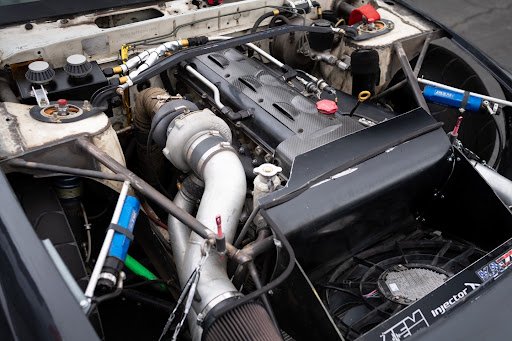Peter's 2JZ-Swapped S13: Tweaking the Famous Drift Recipe
Photos: Luke Munnell
After an itinerant adolescence filled with drifting and hot rodding, Peter Hong relocated to Los Angeles, where his friend turned him onto track days. He picked up an E46 M3 and started running laps, but the cost of the car, as well as his fondness for the cars of his youth, compelled him to make a change.
His aim was rooted in pragmatism and thriftiness. Peter wanted to see if his S13 would handle as well as his M3 because, as he puts it, “then I wouldn’t need two cars.”
His background in drifting meant he’d already learned a lot about the chassis. Having been through five of them, some with swapped engines, he knew that the potential to find a nice balance between power and agility was there if he executed the build properly. Plus, with prices being what they were a decade ago, a well-modified S13 wouldn’t break the bank.
The first iterations of the car were as basic as can be. Aside from swapping in an SR20, the car had little more than basic bolt-ons and set of Hankook RS4s. Yet, contrary to popular opinion, it worked well on the road course.
Entry-level Ohlins, Z32 brakes, a Carbonetics 1.5-way LSD, and a set of Recaros were all the basic bolt-ons needed to make his car work well on the road course. Mild engine mods yielded 250 at the wheels—more than enough for a 2,800-pound car—and the sense of security from his six-point welded cage encouraged him to push the car hard.
“It’s such an intuitive car at that power level. I got down to 1:27s at Streets of Willow pretty fast,” he recalled. Achieving that time in a car requiring little maintenance was bliss; he’d managed to invest minimally and still extract plenty of performance. This was before he decided to wander off into the land of diminishing returns on his investment.
The last of the basic bolt-ons was aero. After throwing some of the APR catalog at the car, Peter was astounded with how well the once-ponderous front end would turn.
Adding power and a set of Brembo F40 brakes helped Peter lap Buttonwillow 13CW in 1:51.
But respectable isn’t really that satisfying in the short term, so Peter, carried away by his curiosity, decided to increase power. A succession of different turbos, an AEM standalone, high-lift cams, and minor porting eventually brought the power output to 390, but not before he went through a few engines.
It wasn’t that the hikes in power—each new motor made about fifty more than the last—stressed them to the failure point. Actually, the most powerful iteration lasted ten events before it spun a rod. Little did he know that slapping on a set of Pirelli scrubs and running the banking at Auto Club Speedway was denying the SR its lubrication. This happened three times, and every time he spun a rod, he just grabbed a new powerplant and got on with it. To be fair, this was easier to do when an engine could be found for a fifth of what they’re worth today.
However, the regular rebuilds challenged Peter’s patience. Seeking a more reliable motor that could produce more power safely, he started weighing the options. The weight and accessibility of the LS tempted him briefly, but a friend who’d just parked their fourth-generation Supra offered him its engine for a friends-only price. Again, it was Peter’s frugality that helped this “deal” along, and soon he had the Supra’s straight-six in his possession.
Unlike the SR, the 2JZ-GTE requires a lot of work when fitting it into an S-chassis’s engine bay, but with various sponsorships, he could make the transition to straight-six power pleasantly. AEM provided the ECU, Beau Brown tuned the engine, Kaizen Motorsports handled the wiring and plumbing, and HeliarcWorks did the fabrication; much of the front was tube-framed to compensate for the 2JZ’s weight. To safeguard himself from the starvation issues he’d dealt with before, he added a baffle and eventually an Accusump.
“It’s not laggy enough!” he laughed.
This time, he wanted to ensure the motor wouldn’t be the weak link. After mounting the radiator in the rear and a massive intercooler up front, he laid them both at 45° angles and devised all the ducting needed to ensure a steady supply of cool air.
The issue was no longer reliability. Instead, it was power—or too much of it. The oversized 90mm throttle body, log manifold, and hefty Comp 6467 turbocharger caused boost to hit like a steam hammer low in the rev range. With 450 lb-ft available at 3,500 rpm and a spiky delivery, the engine made far more than what the car and driver could realistically handle.
The lack of drivability forced Peter to try a few solutions: 295-section rear tires, a larger APR GT1000 wing, and better tires. These helped, but since the wheelspin was worst at lower speeds, he tried toying with the alignment.
Actually, he studied it. After installing a set of Powered by Max drop knuckles, he threw the car up on an alignment rack and started analyzing. These corrected camber and toe gain on compression and improved the control arm angle, resulting in optimized traction and reduced tire wear, but as the footage below shows, it’s still an animal.
Peter has decided to try a new platform and is selling this amazing car. Those interested can check the listing here.







